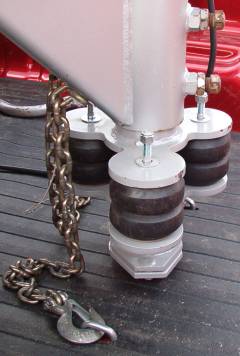


When I review a new product, I like to use it on other folks trucks and trailers. Not that I wouldn't mind keeping all this cool stuff, but I want more opinions from the real world. Kenny Brown volunteered to help me evaluate this new Cushion Glide Coupler on his Exiss 20' aluminum stock trailer. Installation of the new cushion coupler was a snap, just loosen the two adjustable coupler tube wedge bolts and the old coupler falls out, watch your toes. Slide the Cushion Glide Coupler up the neck tube and retighten the two wedge (set) bolts and you are ready to go. I did measure first were the old coupler was, so I have a place to start adjusting the new cushion coupler. We used model CG4000 with a 4000# tongue weight rating.
|
|
|
Kenny Brown's rig, a 03 Ford F250 8' bed, diesel with factory "camper package", B&W ball hitch and 20' box Exiss aluminum stock trailer. The unit was setup relatively level. We setup the Cushion Glide Coupler down about an inch more than the standard hitch, raising the front of the trailer, to be level when loaded with 2 to 3 horses as Kenny's most common load and not be too high in the front when empty, so as not to affect the trailer brakes. |
 The standard coupler. The standard coupler. |
 The new hitch, Cushion Glide Coupler The new hitch, Cushion Glide Coupler |
 The one thing I was concerned about, is with the larger head on the coupler, would there still be enough room to lower the front of the trailer with the adjustable neck? I could see that raising the trailer would be no problem. We drove the trailer with a couple of horses (2500#'s) loaded in the front compartment, to give us an idea of where to adjust the coupler for a heavy load. When I had the coupler adjusted to be level on the loaded trailer, we still had 2 inches of adjustment left between the coupler top Timbren rubber spring bracket and the gooseneck tube. And two inches is a lot, so I was satisfied that Rehme Mfg. did their homework measuring goosenecks and trucks.
The one thing I was concerned about, is with the larger head on the coupler, would there still be enough room to lower the front of the trailer with the adjustable neck? I could see that raising the trailer would be no problem. We drove the trailer with a couple of horses (2500#'s) loaded in the front compartment, to give us an idea of where to adjust the coupler for a heavy load. When I had the coupler adjusted to be level on the loaded trailer, we still had 2 inches of adjustment left between the coupler top Timbren rubber spring bracket and the gooseneck tube. And two inches is a lot, so I was satisfied that Rehme Mfg. did their homework measuring goosenecks and trucks.
Kenny and I both drove the truck and trailer with the old coupler, the new coupler empty and loaded with 2 horses (approximately 2500#'s) in the front compartment and then split up with the heaviest, 16 hand Quarter Horse in the rear compartment. I didn't see a big difference with the empty trailer before and after we added the Cushion Glide Coupler. We crossed a railroad track and could see some movement in the Timbren rubber springs. Loaded you could feel a difference in an improved ride with Cushion Glide Coupler. We drove on pavement and dirt roads.
The biggest difference I could see was in slowing down, speeding up, starting and stopping. The Cushion Glide Coupler took the shock out of the movement. Have an improved ride is nice but reducing the jerk between the truck and trailer impressed me. I drive in heavy traffic in Denver and try as you might to allow room between you and other drivers and the gap just keeps filling in with those little cars. So when your truck pitches forward in a panic stop, this coupler can help cushion the jolt and rebound from the sudden stop.

It even matches the color of your gooseneck and your spare tire! The bottom of the Cushion Glide Coupler is tapered inward to allow easier ball hookup, even if you aren't perfect at backing up your trailer. Now of course the ultimate test was Kenny Browns wife, Sandy. She drove the truck and trailer at the end of our grueling test drives while Kenny and I rested in the barn near the refrigerator. And Sandy's quote was "the hitch makes the truck and trailer ride better." What else can I say except that Kenny just got back from a 2000 mile trip from Ft. Collins Colorado to Farmington and Clovis New Mexico and back, hauling a couple of mares (approximately 2400#'s) using the CGC. This long term test was successful, Kenny noticed less horse motion from the trailer verses other similar trips. He also stated that his F250 felt more like the stability you notice with a dually.
Original Story click on Mr. Truck
I'll have more specifications on my website and the results of U-Hauls SAE testing of the Cushion Glide Coupler. Check out their website, http://cushionglide.com/
|
|
|
Happy horse, fun ride, just getting annoyed by the goofy guy with the camera, probably the same guy driving me in circles with his head out the window! |